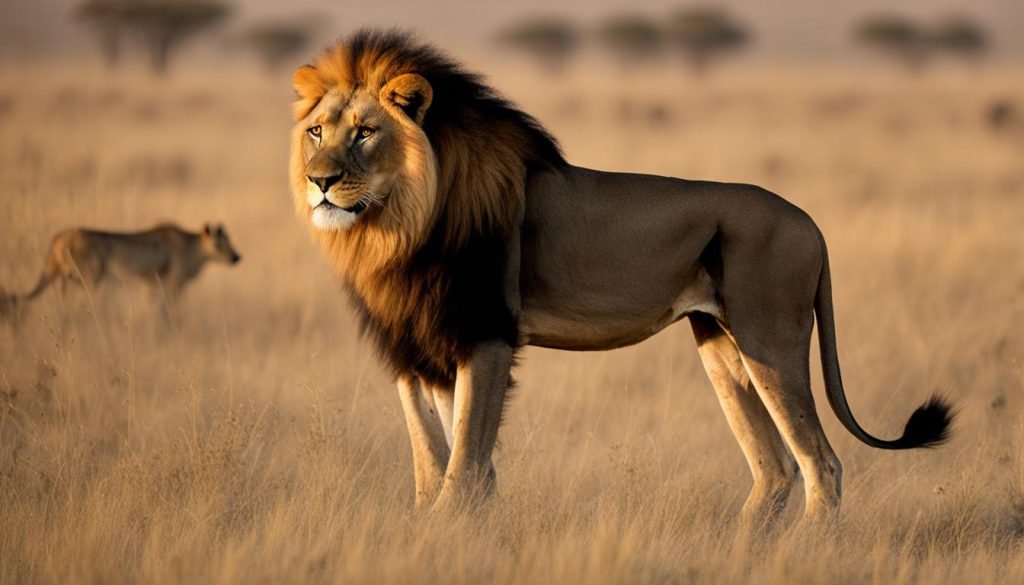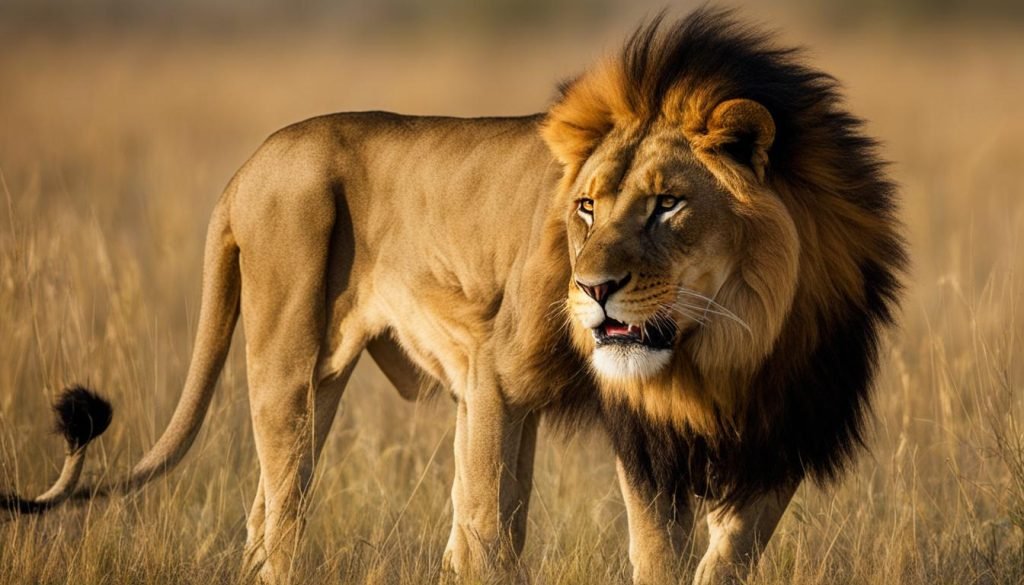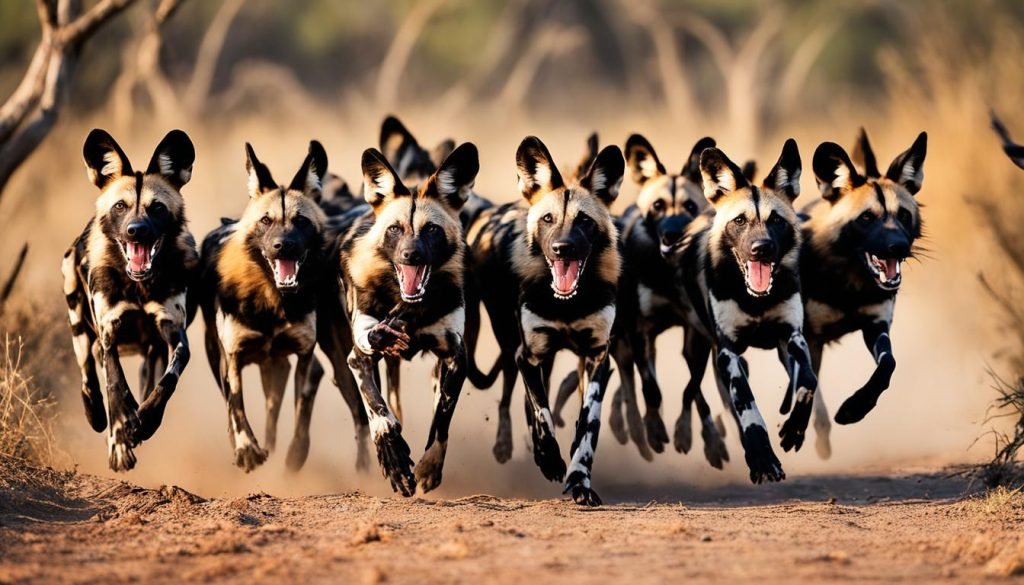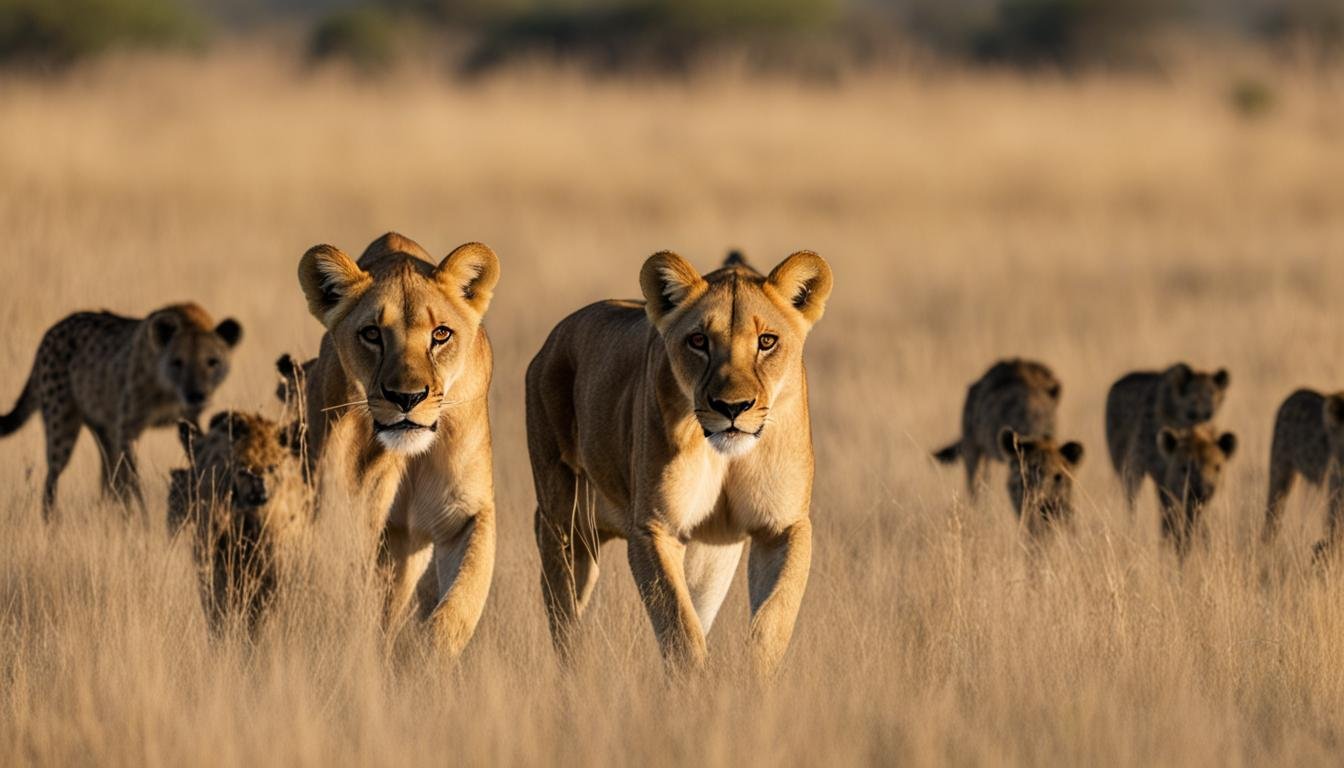Do Lions Have Predators? Lion Threats Explained
Lions are one of the most well-known big cats and a symbol of strength, courage, and royalty. Many people perceive lions as fearless and invincible animals, but do they have predators?
Despite being at the top of the food chain, lions do have natural predators in the wild. These predators are the apex predators that share the same habitat as lions and compete for the same resources. Knowing these predators is vital in understanding the challenges lions face in their survival.
Key Takeaways
- Lions have natural predators in the wild
- Apex predators are the greatest threats to lions
- Understanding lion predators is crucial to conservation efforts
- Lions play a significant role in maintaining ecosystems
- Human activities also pose a threat to lion populations
Understanding Lion Predators in the Wild

Lions may be the kings of the jungle, but they are not invincible. In fact, there are numerous predators in the wild that pose a threat to their survival. Understanding these natural enemies is crucial in gaining insight into the challenges lions face on a daily basis.
At the top of the list of predators that hunt lions are hyenas, leopards, cheetahs, and African wild dogs. Each of these predators employs unique hunting strategies to outsmart and overpower lions in the wild. However, lions are also known to engage in retaliatory attacks against these predators, particularly when they perceive a threat to their cubs.
One of the most formidable competitors for lions in the wild is the spotted hyena. Known for their exceptional stamina, intelligence, and teamwork, hyenas can overpower lions in numbers and have been known to steal their kills. Their relationship with lions is complex, with instances of both predation and competition.
Leopards, on the other hand, pose a serious threat to young and vulnerable lions. These solitary predators are known for their stealthy approach and powerful attacks, often targeting cubs when the opportunity arises.
Cheetahs are also among the top predators of lions, utilizing their incredible speed and agility to hunt down prey. However, they are known to avoid confrontations with lions whenever possible, as they are no match for these powerful predators in a direct confrontation.
African wild dogs may not be as well-known as other predators, but they are some of the most efficient hunters. These pack animals are known for their coordinated hunting behavior, which allows them to take down prey much larger than themselves. While they typically avoid direct confrontation with lions, they have been known to pose a threat to vulnerable cubs or injured adults.
Overall, the threats that lions face from predators in the wild are significant. Understanding the strategies and behaviors of these predators is crucial in developing effective conservation efforts to protect lion populations.
Lion Prey and Predators: A Delicate Balance

The survival of lions is closely linked to their prey and the predators they encounter. Lions are apex predators and occupy the top of the food chain in their habitat. However, they are not invincible. Lions face a delicate balance of finding food while avoiding becoming prey themselves.
Lions’ natural prey includes large herbivores such as zebras, wildebeests, and buffalos. When herbivore populations decline, lions may turn to smaller prey, such as antelopes and gazelles, or scavenge for food.
Fun Fact: Lions are not picky eaters and will consume nearly any animal they can catch, including insects, reptiles, and rodents.
In addition to finding food, lions must also navigate the predators that are a constant threat to them. Some of the top predators of lions include:
| Predator | Threat Level |
|---|---|
| Hyenas | High |
| African wild dogs | High |
| Leopards | Moderate to High |
| Cheetahs | Low to Moderate |
Despite the threat predators pose to lion survival, they play an essential role in maintaining healthy ecosystems. Predators help control the populations of herbivores, which, in turn, helps keep the vegetation in check.
“Predator-prey interactions are vital for maintaining ecological balance in the wild. The delicate balance between hunters and hunted is what keeps the ecosystem healthy,” says wildlife expert Dr. Jane Foster.
The relationship between lions and their prey and predators is closely intertwined, and any disruption can lead to adverse effects on ecosystems, including habitat degradation, species extinction, and declining biodiversity. As such, conservation efforts are crucial in protecting lion populations from endangerment and ensuring a sustainable future for these magnificent creatures.
Apex Predators: The Most Dangerous Threats for Lions

While lions are apex predators in their own right, they still face formidable threats from other top predators in their habitat. Understanding how these natural enemies hunt and prey upon lions is crucial in fully comprehending the challenges that lions face in their struggle to survive.
The Most Dangerous Predators for Lions
Among the most dangerous top predators that lions encounter are hyenas, African wild dogs, and leopards. These natural enemies are all highly skilled hunters and employ various strategies to take down lions, including ambush tactics and pack hunting.
Hyenas in particular have been known to launch vicious attacks on lions, stealing their prey and even targeting lion cubs. African wild dogs hunt in packs and can surround and exhaust lion prey, making them easier targets for attack.
Surviving in a Predator-Filled Habitat
Despite the challenges they face from natural predators, lions have evolved skills and strategies to defend themselves and their territories. For example, lion prides work together to protect their young and ward off potential threats.
| Predator | Threat Level | Strategy |
|---|---|---|
| Hyenas | High | Ambush tactics, pack hunting |
| African Wild Dogs | High | Pack hunting, surround and exhaust prey |
| Leopards | Moderate | Territorial conflicts, ambush tactics |
| Cheetahs | Low | High-speed chases, single prey targeting |
However, with increasing human encroachment on lion territories and the threat of poaching, conservation efforts are more critical than ever to preserving these majestic creatures and ensuring their survival in the wild.
Lions vs. Hyenas: A Historic Rivalry
The rivalry between lions and hyenas stretches back centuries, with both species often competing for food and territory in the savannahs of Africa.
While lions are seen as the iconic kings of the jungle, hyenas are often unfairly portrayed as villainous scavengers. In reality, they are formidable predators that can take down large prey, including lions.
Hyenas live in large packs and have a highly organized social structure. This allows them to coordinate their efforts and take on larger prey than they would be able to tackle alone. Lions, on the other hand, live in smaller groups and have a more intricate social structure with a dominant male leading the pride.
“In reality, they are formidable predators that can take down large prey, including lions.”
The rivalry between the two species comes to a head when they encounter each other at a kill site. Hyenas are known for their scavenging abilities and often steal prey from lions. However, they are also known to launch attacks on lions, particularly when the pride is weaker or if they outnumber them.
Despite being formidable opponents, lions have been known to fall victim to hyena attacks. In some cases, hyenas have been known to kill lion cubs, which can significantly impact the pride’s survival. This rivalry between the two species is a fascinating aspect of the African savannah and continues to intrigue researchers and wildlife enthusiasts alike.
Challenges from African Wild Dogs

African wild dogs are formidable predators known for their pack-hunting techniques in the African savannah. While lions are top predators in the wild, African wild dogs are known to pose a significant threat to their survival. These dogs, also known as painted wolves, are opportunistic hunters who are capable of taking down much larger prey than themselves.
There have been instances where African wild dogs have targeted lion cubs, leading to conflict between the two predators. In fact, research shows that African wild dogs are responsible for up to 1% of lion cub deaths in certain areas of Africa.
One reason why African wild dogs are successful hunters is their ability to work as a team and communicate effectively with each other during the hunt. They have a unique vocalization system and often coordinate with each other to corner and isolate their prey.
The impact of African wild dogs on lion populations varies depending on the region and ecosystem. In some areas, they have been known to influence lion behavior, causing them to adapt their hunting strategies and avoid confrontations with these smaller yet formidable canids.
Despite the challenges posed by African wild dogs, conserving their populations is crucial to maintaining the balance of African ecosystems. By understanding the intricate relationships between predators in the wild, we can develop effective strategies for preserving these magnificent species and their habitats.
The Intriguing Relationship between Lions and Leopards
Lions and leopards share the same habitats and often come into conflict with one another. While lions are known to be apex predators, leopards are formidable hunters that can take down prey larger than themselves. In some cases, leopards have been known to prey on lion cubs, causing tension between the two species.
However, these conflicts are not always one-sided. Lions have been known to attack and kill leopards, particularly when they feel threatened or when competition for resources is high. In fact, research has shown that leopards actively avoid areas where lions are present to reduce the risk of conflict.
To reduce conflict and improve the survival chances of both species, conservationists have worked to create buffer zones between lion and leopard habitats. These zones provide each predator with enough space to hunt and thrive without coming into direct competition with one another.
“Lions have been known to attack and kill leopards, particularly when they feel threatened or when competition for resources is high.”
Leopard Predation on Lions
Instances of leopard predation on lions have been documented in the wild. For example, in Botswana’s Okavango Delta, a female leopard was observed dragging a young lioness up a tree. However, these cases are rare, and lions typically pose a greater threat to leopards than vice versa.
| Lion vs Leopard | Winner |
|---|---|
| 1-on-1 fight | Lion |
| Group vs Group | Lion |
| Group vs 1 | Lion |
As seen in the table above, lions are generally stronger and bigger than leopards, making them more likely to emerge victorious in encounters between the two species.
In conclusion, the relationship between lions and leopards is complex and dynamic. While conflicts between the two predators do occur, they also coexist peacefully in some habitats. Conservation efforts aimed at reducing such conflicts and preserving both species are essential for ensuring their long-term survival in the wild.
Other Competitors in the Wild: Lions and Cheetahs
While lions are known for their majestic manes and fearsome roars, they are not the only top predators in the African savannah. Cheetahs, with their incredible speed and agility, also pose a threat to the lion’s dominance in the wild.
Although cheetahs are not typically thought of as lion predators, they have been known to hunt lion cubs if their primary prey is scarce. Additionally, cheetahs are able to outrun and outmaneuver lions, making them formidable competitors when they share a habitat.
However, despite their shared status as top predators, lions and cheetahs have distinct hunting strategies that minimize direct competition. Lions often hunt in groups, relying on strength in numbers and strategic attacks to bring down larger prey, while cheetahs hunt alone and favor smaller, faster games.
Interestingly, research suggests that cheetahs may avoid areas where lions are present, indicating a level of deference and competition avoidance between the two species.
“While both lions and cheetahs are skilled and deadly predators, they have evolved tactics and strategies that enable them to coexist and minimize direct competition.” – Dr. Jane Goodman
Human Influence as a Predator of Lions
While natural predators certainly pose a threat to lion populations, humans are also a significant factor contributing to their decline. Lion poaching, in particular, is a major problem throughout Africa, fueled by the demand for lion parts in traditional medicine and as trophies for hunters.
Lion habitat loss is another significant human influence that puts pressure on lion populations. As human populations grow and expand into previously wild areas, lion habitats shrink. This limits the space available for lions to roam and hunt and increases the likelihood of human-lion interactions, which can be deadly for both parties.
“As humans continue to encroach on lion habitats and exploit them for their own gain, it’s crucial that we take action to protect these magnificent animals before it’s too late.”
Human Threats to Lion Populations
| Human Activity | Impact on Lion Populations |
|---|---|
| Lion Poaching | Reduces lion populations, disrupts social structure of lion prides |
| Lion Habitat Loss | Reduces lion populations, disrupts the social structure of lion prides, alters the genetics of lion populations |
| Trophy Hunting | Encroaches on lion habitats, limited resources for lions, increased human-lion conflict |
| Cattle Ranching and Farming | Encroaches on lion habitats, limited resources for lions, increases human-lion conflict |
The impact of human activities on lion populations is a complex issue, with no easy solutions. Nonetheless, conservation efforts continue to play a crucial role in protecting these majestic animals. By supporting organizations dedicated to preserving lion habitats, combating poaching activities, and promoting coexistence between humans and lions, we can help ensure a brighter future for these vulnerable creatures.
Conservation Efforts for Lion Protection
Protecting lions from predators and human threats has become a global concern. Lion conservation initiatives have been established to address this issue. These conservation efforts aim to protect lion populations, preserve their habitat, and promote awareness about their ecological importance. Here are some of the conservation initiatives:
1. Lion Guardians
Lion Guardians is a nonprofit organization that partners with local Maasai communities in Kenya and Tanzania to protect lions. The organization promotes peaceful coexistence between lions and humans by employing Maasai warriors to monitor lion populations, track their movements, and prevent human-lion conflicts. The Lion Guardians have helped increase lion populations in certain regions by 10-20%.
2. Panthera’s Lion Program
Panthera’s Lion Program is an innovative initiative that focuses on conserving lion populations in Africa. The program works in collaboration with local partners to protect lions and their habitats, prevent poaching, and promote sustainable tourism. The goal of the program is to double lion populations in priority landscapes by 2050.
3. African Parks
African Parks is a non-profit conservation organization that manages national parks across Africa. The organization works with local communities to protect wildlife and their habitats. In Malawi, African Parks has successfully reintroduced lions into Liwonde National Park, which had no resident lions for nearly 20 years.
4. Project Leonardo
Project Leonardo is a partnership between the Wildlife Conservation Network and the Leonardo DiCaprio Foundation. The initiative supports local conservation organizations in their efforts to protect lions and other big cats. Project Leonardo also funds research to better understand big cat behavior and improve conservation strategies.
“In the end, we will conserve only what we love; we will love only what we understand and we will understand only what we are taught.” – Baba Dioum
It is crucial to protect lions from predators and human threats to maintain healthy ecosystems and preserve biodiversity. Through these lion conservation initiatives, we can work towards creating a world where lions and humans peacefully coexist.
Conclusion
Our exploration of lion predators has revealed the complex interplay between these powerful predators and their natural enemies. From apex predators like crocodiles and hyenas to human threats like habitat loss and poaching, lions face significant challenges in their survival.
However, conservation efforts are underway to protect lion populations and preserve their critical role in ecosystems. By better understanding these threats and the delicate balance between lion prey and predators, we can work to ensure their survival for generations to come.
Whether facing off against a rival predator or navigating human-induced threats, lions remain a symbol of strength and resilience in the wild. It is up to us to protect these majestic creatures and the world they inhabit through ongoing conservation initiatives.
More About Lions:
- How Long Do Lions Live? Wild vs Captivity
- Male vs Female Lion: Key Differences Explained
- What Do Lions Do All Day?
- What Do Lions Do During the Night?
- How Do Lions Communicate With Each Other?
- Where Do Lions Sleep?
- How Fast Can Lions Run?
- Can Lions Swim? Lion’s Swimming Ability Examined
- How Do Elephants Mate?
- Cannibalism in Lions: Do Lions Eat Other Lions?
- How Long Are Lions Pregnant? Gestation Period
- Do Lions Hibernate During Winter?
- How Much Do Lions Weigh? Lion’s Weight Revealed







